Impacts of Urbanization on River Systems in the Taihu Region, China
Abstract
:1. Introduction
2. Material and Methods
2.1. Study Area
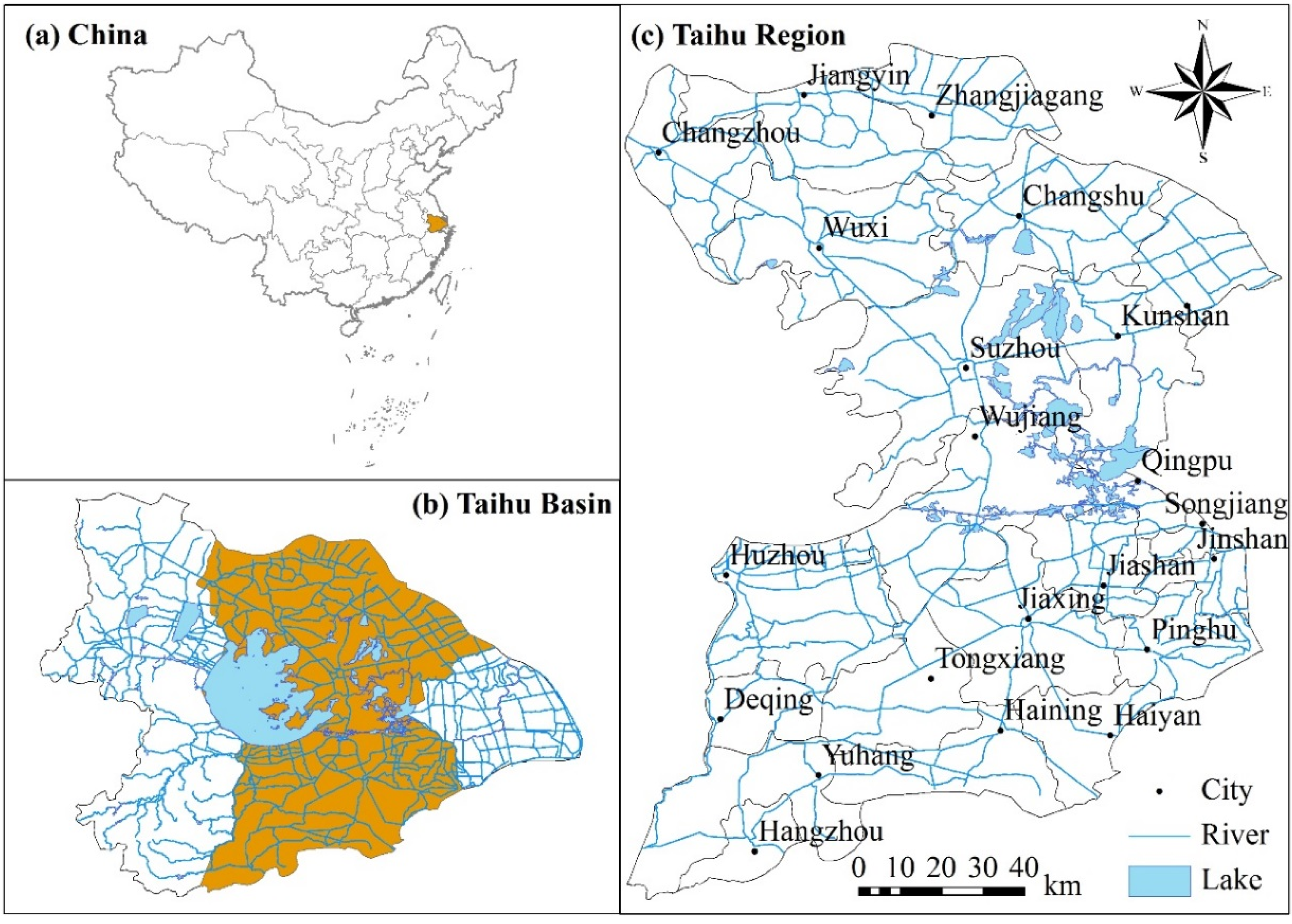
2.2. Data
2.3. River and Urbanization Indicators
2.3.1. River Density
2.3.2. Water Surface Ratio
2.3.3. River Development Coefficient
2.3.4. River Sinuosity
2.3.5. Main River Area Length Ratio
2.3.6. Box Dimension
2.3.7. Urbanization Indicators
| Classification | Characteristic Indicators | Computational Methods |
|---|---|---|
| Population urbanization | Population urbanization level (Up) | The ratio of urban population to total population |
| Economic urbanization | Economic urbanization level (Ue) | The ratio of non-agricultural GDP to total GDP |
| Spatial urbanization | Spatial urbanization level (Us) | The ratio of urban land area to total area |
2.4. Grey Relational Analysis
- (1)
- Setting of the sequences.
- (2)
- Normalization of the variables.
- (3)
- Determine the relational coefficients.
- (4)
- Calculation of the relational degrees.
- (5)
- Sorting the relational degrees.
3. Results
3.1. Total Change of River Systems
| Years | Dr (km/km2) | Wp (%) | Kω | Sr | Rm (km2/km) | D0 |
|---|---|---|---|---|---|---|
| 1960s | 3.69 | 12.00 | 3.48 | 1.12 | 43.91 | 1.70 |
| 1980s | 3.43 | 11.12 | 3.13 | 1.10 | 46.41 | 1.67 |
| 2010s | 3.07 | 9.72 | 2.44 | 1.09 | 43.56 | 1.59 |
3.2. Temporal Change of River Systems
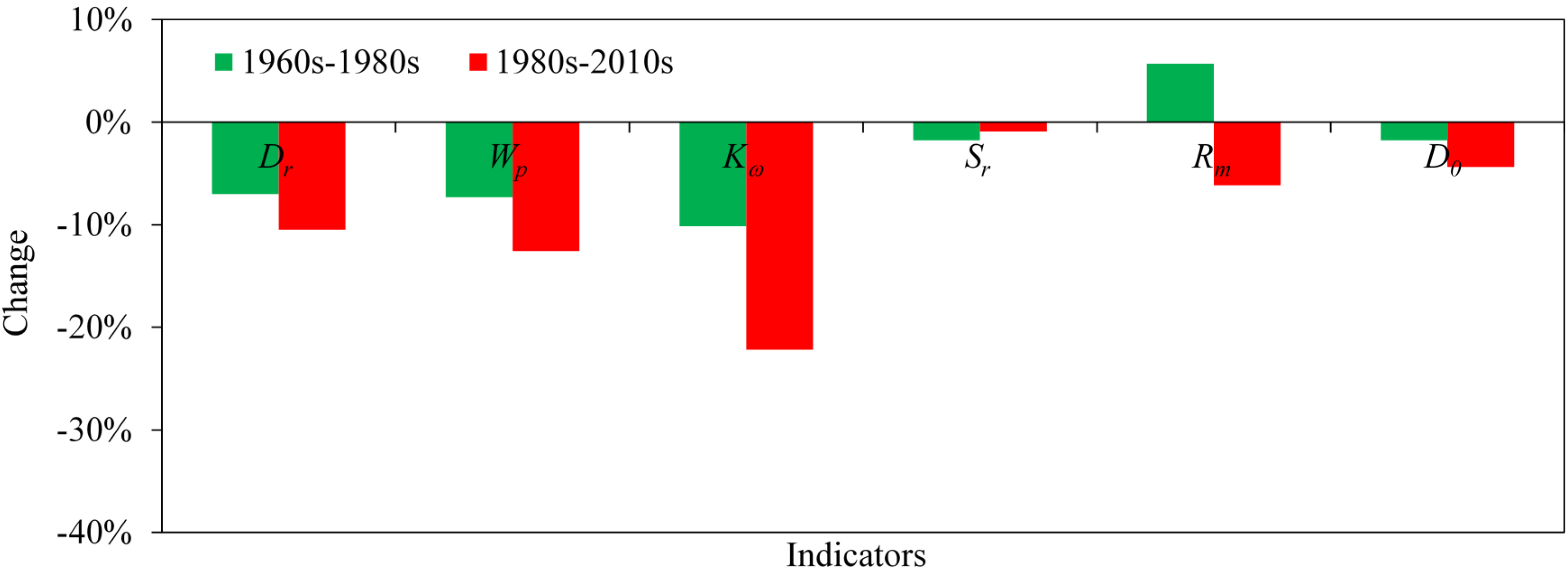
3.3. Spatial Change of River Systems
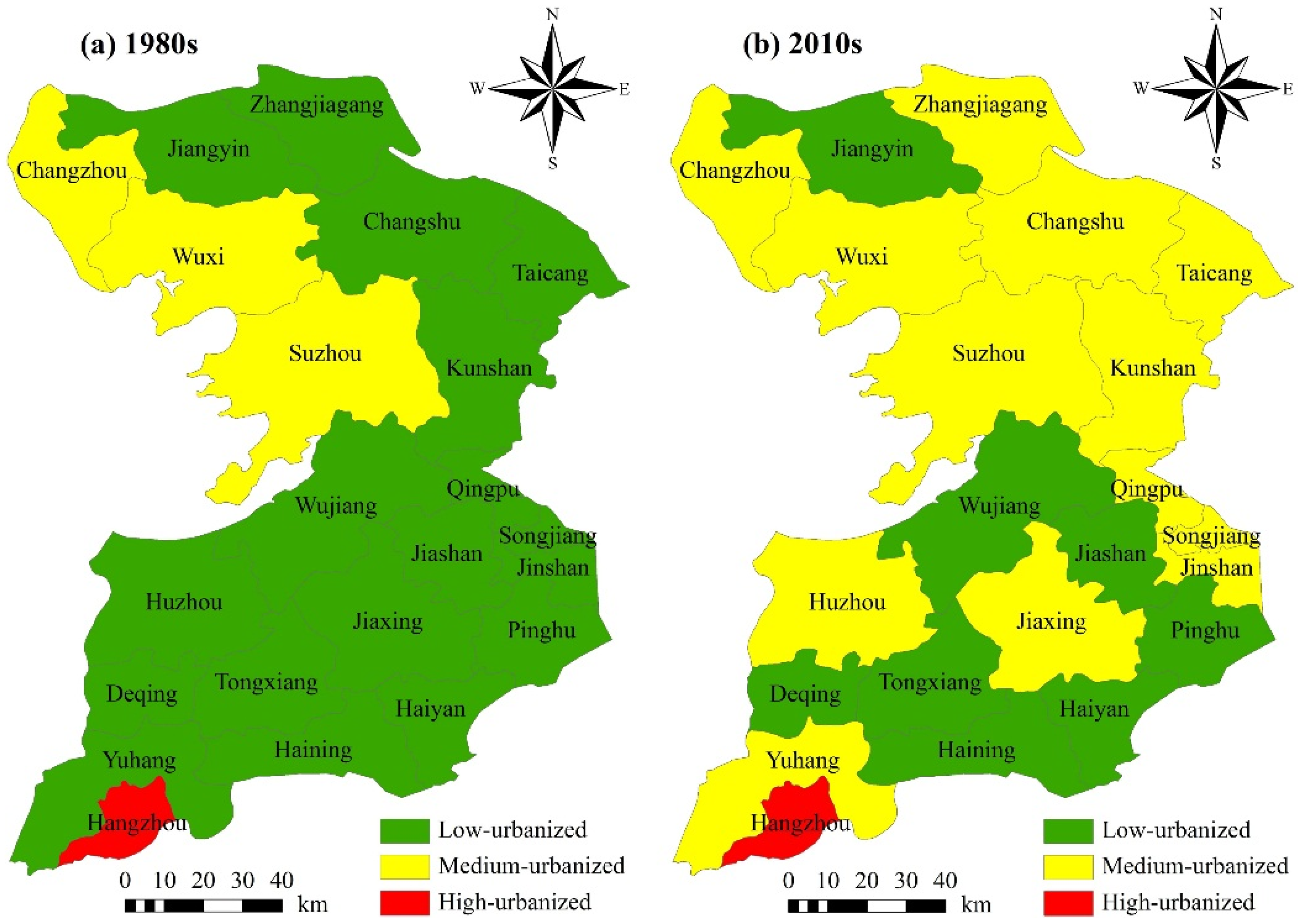
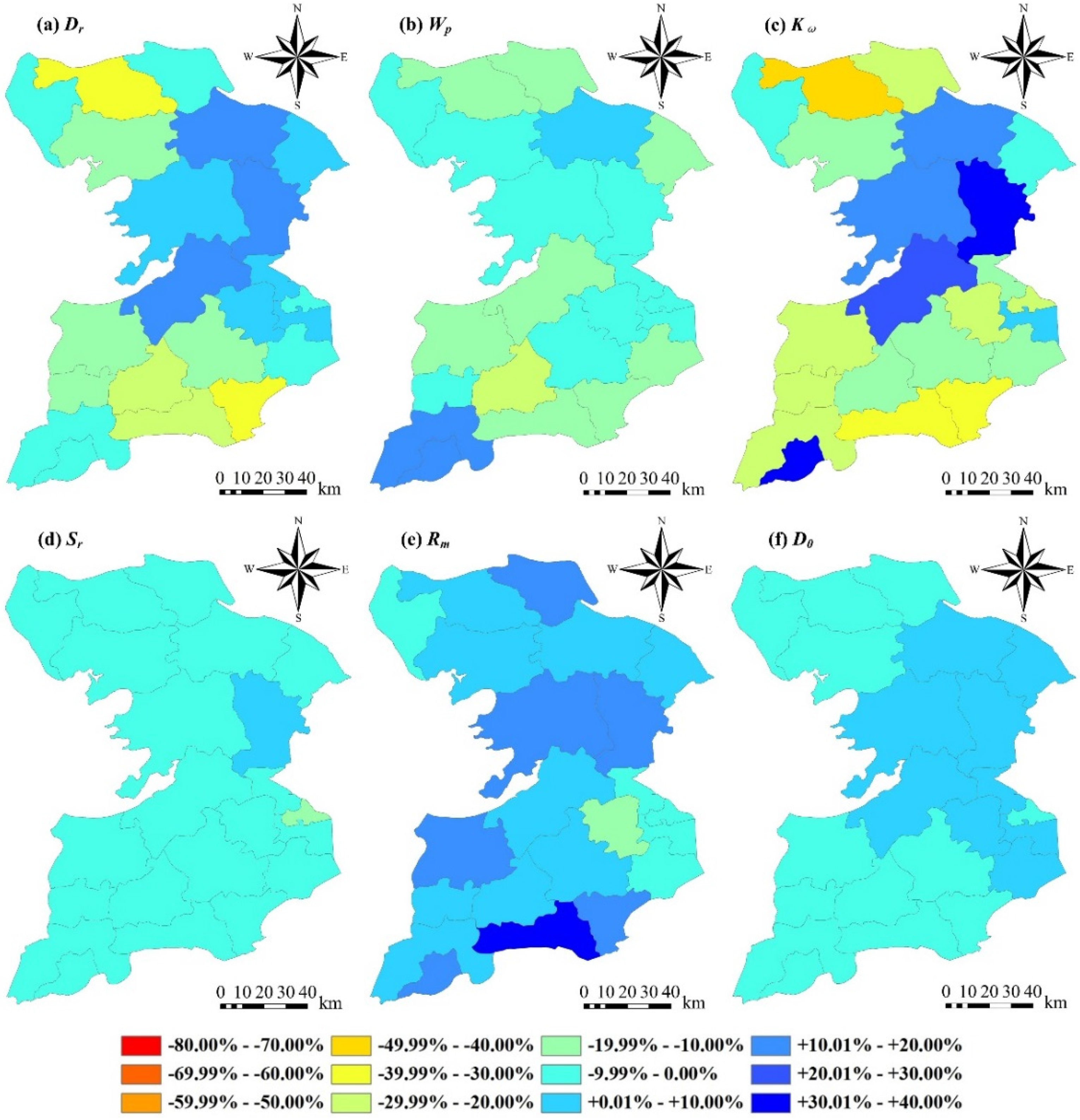
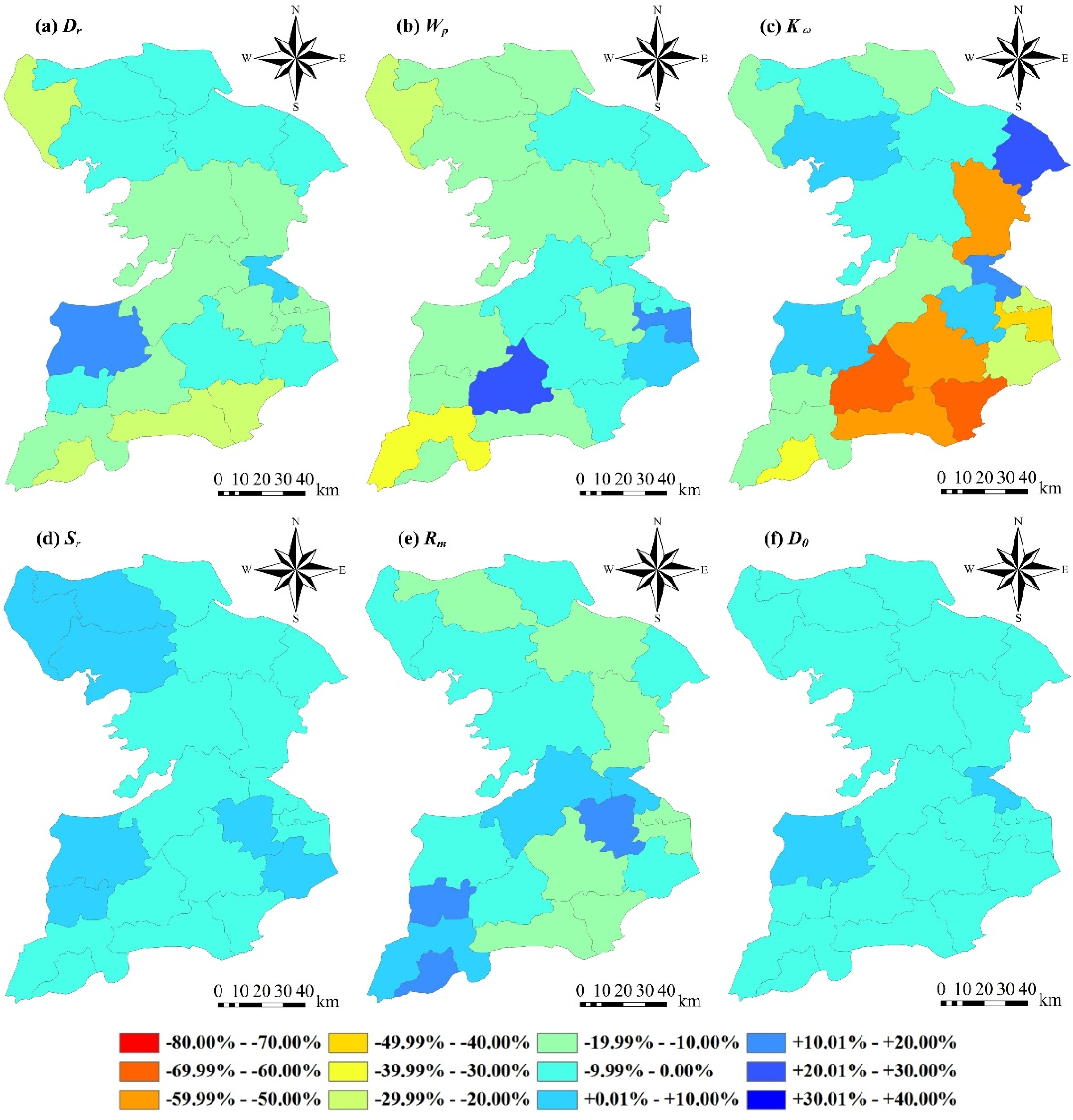
3.4. Impacts of Urbanization on River Systems
| 1960s–1980s | Dr | Wp | Kω | Sr | Rm | D0 | Average |
|---|---|---|---|---|---|---|---|
| Up | 0.6138 | 0.7534 | 0.6923 | 0.7290 | 0.7493 | 0.6945 | 0.7054 |
| Ue | 0.6076 | 0.6962 | 0.6699 | 0.7521 | 0.7647 | 0.6005 | 0.6818 |
| Us | 0.6085 | 0.7605 | 0.7615 | 0.6609 | 0.7133 | 0.5964 | 0.6835 |
| Average | 0.6100 | 0.7367 | 0.7079 | 0.7140 | 0.7424 | 0.6305 | -- |
| 1980s–2010s | Dr | Wp | Kω | Sr | Rm | D0 | Average |
| Up | 0.6793 | 0.6900 | 0.6349 | 0.6736 | 0.6753 | 0.7011 | 0.6757 |
| Ue | 0.6830 | 0.6994 | 0.6323 | 0.6701 | 0.6358 | 0.6728 | 0.6656 |
| Us | 0.6494 | 0.7052 | 0.6264 | 0.7113 | 0.6108 | 0.7064 | 0.6683 |
| Average | 0.6706 | 0.6982 | 0.6312 | 0.6850 | 0.6406 | 0.6934 | -- |
4 Discussions
4.1. River Systems Changes
4.2. Urbanization Impacts
5 Conclusions
- (1)
- The number of river systems decreased drastically, the morphology of river channels changed into wider and straighter and the structure of the river network tended to simplify in the Taihu Region in the recent 50 years; due to the decrease of the natural winding tributaries and the shrinking of lakes, as well as the increase of the straighter main rivers.
- (2)
- Under the influence of drastic land use change and increasing flood risk, the changes in Dr, Wp, Kω, Rm and D0 in the rapid urbanization period were much greater than those in the slow urbanization period. However, the decrease of Sr in the slow urbanization period was more intense, which might be related to a host of winding rivers having been straightened during the extensive water conservancy constructions.
- (3)
- There were wide spatial differences in river system changes in the Taihu Region over the past 50 years. In contrast, the spatial differences of the changes in Sr and D0 are small, but the spatial differences of the changes in Kω were the largest. Furthermore, the changes in river indicators in the low-urbanized regions were the most intense.
- (4)
- The changes in river systems were closely correlated with urbanization; however, the changes in Wp had the closest correlation with urbanization, and the relational degrees between Up and the changes in river systems were the largest in the Taihu Region.
Acknowledgments
Author Contribution
Conflicts of Interest
References
- Nilsson, C.; Reidy, C.A.; Dynesius, M.; Revenga, C. Fragmentation and flow regulation of the world’s large river systems. Science 2005, 308, 405–408. [Google Scholar] [CrossRef] [PubMed]
- Sear, D.A.; Newson, M.D. Environmental change in river channels: A neglected element. Towards geomorphological typologies, standards and monitoring. Sci. Total Environ. 2003, 310, 17–23. [Google Scholar] [CrossRef] [PubMed]
- Karr, J.R. Defining and measuring river health. Freshw. Biol. 1999, 41, 221–234. [Google Scholar] [CrossRef]
- Steele, M.K.; Heffernan, J.B. Morphological characteristics of urban water bodies: Mechanisms of change and implications for ecosystem function. Ecol. Appl. 2014, 24, 1070–1084. [Google Scholar] [CrossRef] [PubMed]
- Pinto, U.; Maheshwari, B.L. River health assessment in peri-urban landscapes: An application of multivariate analysis to identify the key variables. Water Res. 2011, 45, 3915–3924. [Google Scholar] [CrossRef] [PubMed]
- Walsh, C.J.; Roy, A.H.; Feminella, J.W.; Cottingham, P.D.; Groffman, P.M.; Morgan, R.P. The urban stream syndrome: Current knowledge and the search for a cure. J. N. Am. Benthol. Soc. 2005, 24, 706–723. [Google Scholar] [CrossRef]
- Xu, Y.P.; Xu, J.T.; Ding, J.J.; Chen, Y.; Yin, Y.X.; Zhang, X.Q. Impacts of urbanization on hydrology in the Yangtze River Delta, China. Water Sci. Technol. 2010, 62, 1221–1229. [Google Scholar] [CrossRef] [PubMed]
- Lane, E.W. The importance of fluvial morphology in hydraulic engineering. Proc. Am. Soc. Civ. Eng. 1955, 81, 1–17. [Google Scholar]
- Chin, A. Urban transformation of river landscapes in a global context. Geomorphology 2006, 79, 460–487. [Google Scholar] [CrossRef]
- Hooke, J.M. Human impacts on fluvial systems in the Mediterranean region. Geomorphology 2006, 79, 311–335. [Google Scholar] [CrossRef]
- Wang, C.P.; Wang, D.Y.; Wang, H.W.; Dong, R.C. Impacts of urbanisation on river systems and their functions in Yanggong River watershed of Lijiang City. Int. J. Sust. Dev. World 2011, 18, 498–502. [Google Scholar] [CrossRef]
- Junior, O.C.; Guimaraes, R.; Freitas, L.; Gomes-Loebmann, D.; Gomes, R.A.; Martins, E.; Montgomery, D.R. Urbanization impacts upon catchment hydrology and gully development using mutli-temporal digital elevation data analysis. Earth Surf. Proc. Land. 2010, 35, 611–617. [Google Scholar]
- Vanacker, V.; Molina, A.; Govers, G.; Poesen, J.; Dercon, G.; Deckers, S. River channel response to short-term human-induced change in landscape connectivity in Andean ecosystems. Geomorphology 2005, 72, 340–353. [Google Scholar] [CrossRef]
- Gregory, K.J. The human role in changing river channels. Geomorphology 2006, 79, 172–191. [Google Scholar] [CrossRef]
- Elmore, A.J.; Kaushal, S.S. Disappearing headwaters: Patterns of stream burial due to urbanization. Front. Ecol. Environ. 2008, 6, 308–312. [Google Scholar] [CrossRef]
- Yuan, W.; Philip, J.; Yang, K. Impact of urbanization on structure and function of river system. Chin. Geogr. Sci. 2006, 16, 102–108. [Google Scholar] [CrossRef]
- Duan, H.; Ma, R.H.; Xu, X.F.; Kong, F.K.; Zhang, S.X.; Kong, W.J.; Hao, J.Y.; Shang, L.L. Two-decade reconstruction of algal blooms in China’s Lake Taihu. Environ. Sci. Technol. 2009, 43, 3522–3528. [Google Scholar] [CrossRef] [PubMed]
- Guan, B.; An, S.; Gu, B. Assessment of ecosystem health during the past 40 years for Lake Taihu in the Yangtze River Delta, China. Limnology 2011, 12, 47–53. [Google Scholar] [CrossRef]
- Wang, L.; Cai, Y.L.; Chen, H.Q.; Daler, D.; Zhao, J.M.; Yang, J. Flood disaster in Taihu Basin, China: Causal chain and policy option analyses. Environ. Earth Sci. 2011, 63, 1119–1124. [Google Scholar] [CrossRef]
- Yang, K.; Yuan, W.; Zhao, J.; Xu, S.Y. Stream structure characteristics and its urbanization responses to tidal river system. Acta Geogr. Sin. 2004, 59, 557–564. (In Chinese) [Google Scholar]
- Zhao, J.; Shan, F.Z.; Yang, K.; Wu, E.N. River sinuosity in tidal plain and its response to rapid urbanization. Adv. Water Sci. 2011, 22, 632–637. (In Chinese) [Google Scholar]
- Wang, J.; Chen, X.; Zhu, X.H.; Liu, J.L.; Chang, W.Y.B. Taihu Lake, lower Yangtze drainage basin: Evolution, sedimentation rate and the sea level. Geomorphology 2001, 41, 183–193. [Google Scholar] [CrossRef]
- Chen, Z.; Wang, Z.H. Yangtze Delta, China: Taihu lake level variation since 1950s, response to sea-level and human impact. Environ. Geol. 1999, 37, 333–339. [Google Scholar] [CrossRef]
- Qin, B.Q.; Xu, P.Z.; Wu, Q.L.; Luo, L.C.; Zhang, Y.L. Environmental issues of lake Taihu, China. Hydrobiologia 2007, 581, 3–14. [Google Scholar] [CrossRef]
- Zhao, H.X.; Duan, X.J.; Stewart, B.; You, B.S.; Jiang, X.W. Spatial correlations between urbanization and river water pollution in the heavily polluted area of Taihu Lake Basin, China. J. Geogr. Sci. 2013, 23, 735–752. [Google Scholar] [CrossRef]
- Liu, L.; Xu, Z.X.; Reynard, N.S.; Hu, C.W.; Jones, R.G. Hydrological analysis for water level projections in Taihu Lake, China. J. Flood Risk Manag. 2013, 6, 14–22. [Google Scholar] [CrossRef]
- Stone, R. China aims to turn tide against toxic lake pollution. Science 2011, 333, 1210–1211. [Google Scholar] [CrossRef] [PubMed]
- Strahler, A.N. Hypsometric (area-altitude) analysis of erosional topography. Geol. Soc. Am. Bull. 1952, 63, 1117–1142. [Google Scholar] [CrossRef]
- Costanza, R.; d’Arge, R.; de Groot, R.; Farber, S.; Grasso, M.; Hannon, B.; Limburg, K.; Naeem, S.; Oneill, R.V.; Paruelo, J.; et al. The value of the world’s ecosystem services and natural capital. Nature 1997, 387, 253–260. [Google Scholar] [CrossRef]
- Leopold, L.B. A View of the River; Harvard University Press: Cambridge, MA, USA, 1994. [Google Scholar]
- Freeman, M.C.; Pringle, C.M.; Jackson, C.R. Hydrologic connectivity and the contribution of stream headwaters to ecological integrity at regional scales. J. Am. Water Resour. Assoc. 2007, 43, 5–14. [Google Scholar] [CrossRef]
- Nadeau, T.L.; Rains, M.C. Hydrological connectivity between headwater streams and downstream waters: How science can inform policy. J. Am. Water Resour. Assoc. 2007, 43, 118–133. [Google Scholar] [CrossRef]
- Roy, A.H.; Dybas, A.L.; Fritz, K.M.; Lubbers, H.R. Urbanization affects the extent and hydrologic permanence of headwater streams in a midwestern US metropolitan area. J. N. Am. Benthol. Soc. 2009, 28, 911–928. [Google Scholar] [CrossRef]
- Ward, J.V. Riverine landscapes: Biodiversity patterns, disturbance regimes, and aquatic conservation. Biol. Conserv. 1998, 83, 269–278. [Google Scholar] [CrossRef]
- Suren, A.M.; Snelder, T.; Scarsbrook, M. Urban Stream Habitat Assessment Method (USHA); National Institute of Water and Atmospheric Research (NIWA): Christchurch, New Zealand, 1998. [Google Scholar]
- Barbour, M.T.; Gerritsen, J.; Snyder, B.D.; Stribling, J.B. Rapid Bioassessment Protocols for Use in Streams and Wadeable Rivers; United States Environmental Protection Agency (USEPA): Washington, DC, USA, 1999.
- Ladson, A.R.; White, L.J.; Doolan, J.A.; Finlayson, B.L.; Hart, B.T.; Lake, P.S.; Tilleard, J.W. Development and testing of an Index of Stream Condition for waterway management in Australia. Freshw. Biol. 1999, 41, 453–468. [Google Scholar] [CrossRef]
- Booth, D.B.; Karr, J.R.; Schauman, S.; Konrad, C.P.; Morley, S.A.; Larson, M.G.; Burges, S.J. Reviving urban streams: Land use, hydrology, biology, and human behavior. J. Am. Water Resour. Assoc. 2004, 40, 1351–1364. [Google Scholar] [CrossRef]
- Aswathy, M.V.; Vijith, H.; Satheesh, R. Factors influencing the sinuosity of Pannagon River, Kottayam, Kerala, India: An assessment using remote sensing and GIS. Environ. Monit. Assess. 2008, 138, 173–180. [Google Scholar] [CrossRef] [PubMed]
- Mandelbrot, B.B. The Fractal Geometry of Nature; W.H. Freeman: New York, NY, USA, 1982. [Google Scholar]
- Dubuc, B.; Quiniou, J.F.; Roques-Carmes, C.; Tricot, C.; Zucker, S.W. Evaluating the fractal dimension of profiles. Phys. Rev. A 1989, 39, 1500–1512. [Google Scholar] [CrossRef] [PubMed]
- La Barbera, P.; Rosso, R. On the fractal dimension of stream networks. Water Resour. Res. 1989, 25, 735–741. [Google Scholar] [CrossRef]
- He, L.H.; Zhao, H. The fractal dimension of river network and its interpretation. Sci. Geogr. Sin. 1996, 16, 124–128. (In Chinese) [Google Scholar]
- Antrop, M. Landscape change and the urbanization process in Europe. Land Urban Plan. 2004, 67, 9–26. [Google Scholar] [CrossRef]
- Ministry of Housing and Urban-Rural Development of the People’s Republic of China (MOHURD). Code for Classification of Urban Land Use and Planning Standards of Development Land (GB 50137–2011); China Building Industry Press: Beijing, China, 2011.
- Liu, S.; Dang, Y.; Fang, Z. Grey System Theory and Its Application; Science Press: Beijing, China, 2004. [Google Scholar]
- Wong, H.; Hu, B.Q.; Ip, W.C.; Xia, J. Change-point analysis of hydrological time series using grey relational method. J. Hydrol. 2006, 324, 323–338. [Google Scholar] [CrossRef]
- Li, X.; Li, G.M.; Zhang, Y. Identifying Major Factors Affecting Groundwater Change in the North China Plain with Grey Relational Analysis. Water 2014, 6, 1581–1600. [Google Scholar] [CrossRef]
- United Nations. Department of Economic and Social Affairs. In World Urbanization Prospects: The 2014 Revision; United Nations: New York, NY, USA, 2014. [Google Scholar]
- Northam, R.M. Urban Geography, 2rd ed.; John Wiley: New York, NY, USA, 1979. [Google Scholar]
- Karmeshu. Demographic models of urbanization. Environ. Plan. B 1988, 15, 47–54. [Google Scholar]
- Chen, Y.X.; Xu, Y.P.; Fu, W.J. Influences of urbanization on river network in the coastal areas of East Zhejiang province. Adv. Water Sci. 2007, 18, 68–73. (In Chinese) [Google Scholar]
- Huang, Y.L.; Wang, Y.L.; Liu, Z.H.; Zeng, X.K.; Chen, L. Stream construction characteristics in rapid urbanization area: Shenzhen city as a case. Geogr. Res. 2008, 27, 1212–1220. (In Chinese) [Google Scholar]
- Xu, G.L.; Xu, Y.P.; Wang, L.Y. Temporal and spatial changes of river systems in Hangzhou-Jiaxing-Huzhou Plain during 1960s-2000s. Acta Geogr. Sin. 2013, 68, 966–974. (In Chinese) [Google Scholar]
- Xu, Y.P. Impacts of Urbanization of the Yangtze River Delta Region on River System in Basins and Hydrological Processes; Science Press: Beijing, China, 2012. (In Chinese) [Google Scholar]
- Ji, X.M.; Xu, Y.P.; Han, L.F.; Yang, L. Impacts of urbanization on river system structure-A case study on Qinhuai River Basin, Yangtze River Delta. Water Sci. Technol. 2014, 70, 671–677. [Google Scholar] [CrossRef] [PubMed]
- Sadler, R.J. A Review of the Enclosure of Watercourses in Agricultural Landscapes and River Headwater Functions; Fisheries and Oceans Canada: Sarnia, ON, Canada, 2004. [Google Scholar]
- Stammler, K.L.; Yates, A.G.; Bailey, R.C. Buried streams: Uncovering a potential threat to aquatic ecosystems. Landsc. Urban Plan. 2013, 114, 37–41. [Google Scholar] [CrossRef]
© 2015 by the authors; licensee MDPI, Basel, Switzerland. This article is an open access article distributed under the terms and conditions of the Creative Commons Attribution license (http://creativecommons.org/licenses/by/4.0/).
Share and Cite
Deng, X.; Xu, Y.; Han, L.; Song, S.; Yang, L.; Li, G.; Wang, Y. Impacts of Urbanization on River Systems in the Taihu Region, China. Water 2015, 7, 1340-1358. https://doi.org/10.3390/w7041340
Deng X, Xu Y, Han L, Song S, Yang L, Li G, Wang Y. Impacts of Urbanization on River Systems in the Taihu Region, China. Water. 2015; 7(4):1340-1358. https://doi.org/10.3390/w7041340
Chicago/Turabian StyleDeng, Xiaojun, Youpeng Xu, Longfei Han, Song Song, Liu Yang, Guang Li, and Yuefeng Wang. 2015. "Impacts of Urbanization on River Systems in the Taihu Region, China" Water 7, no. 4: 1340-1358. https://doi.org/10.3390/w7041340






